FEMA obligations for permanent work in Puerto Rico exceed $19M

While the Federal Emergency Management Agency (FEMA) maintained a fast-paced obligation of funds last year, construction work leads the way toward the revitalization of many communities throughout the island, the agency said.
To date, FEMA has allocated more than $25.7 billion in federal funds, of which more than $19 billion are for permanent work. Hundreds of projects have already been completed, while others are on the initial stages of construction, it added.
“When we attend groundbreaking ceremonies across the island, we take great pride in the duty and responsibility that we have. Each work confirms that the island is on a steady pace toward recovery,” said the Federal Disaster Recovery Coordinator for Puerto Rico, José G. Baquero.
Roads and bridges
The municipality with the greatest number of obligations for permanent repairs to roads and bridges is Jayuya, for a total of $6.3 million to manage projects such as PR-144 in the Las Arenas neighborhood and the Miguel Orlando sector. At a state level, $110 million were also approved in 2021 for the Puerto Rico Department of Transportation and Public Works to repair island roads.
In Puerto Rico’s central region, municipalities like Orocovis and Barranquitas have received allocations that allowed them to repair the main roads for the residents in those communities. Barranquitas was approved more than $300,000, with which it managed to repair the Julián Hernández Road at the Palo Hincado neighborhood, the rural road that grants access to Orocovis, Coamo and different sectors within the municipality.
“Thanks to this project we’re connected to the rest of the community. Some water pipes that were greatly affected were also included. Now our families will be able to have a good quality of life,” said Gerardo Hernández-Ortiz, resident of said community in Barranquitas.
Likewise, the Municipality of Orocovis renovated roads on the Saltos neighborhood, repaired a bridge, a community center and more with an allocation of more than $1.5 million.
“Through the FEMA funds, we made a project to reconnect a bridge with its two ends. We were able to practically connect the communities of Saltos with the town,” said Orocovis Mayor Jesús Colón-Berlingeri.
FEMA Accelerated Awards Strategy
The Accelerated Awards Strategy, known as FAASt, allows the grouping of permanent work critical infrastructure projects for the Puerto Rico Electric Power Authority (PREPA), the Puerto Rico Aqueduct and Sewers Authority (PRASA) and the Puerto Rico Department of Education (PRDE) respectively to speed up the award process, the agency explained.
In January 2021, a total of $3.6 billion was awarded to PRASA through this initiative. One of the works currently underway is PRASA’s Central Laboratory in Caguas, which is considered one of the “most significant” because of the impact of the essential services for thousands of area residents.
Mitigation measures
In terms of measures to prevent damage from future disasters, the Hazard Mitigation Grant Program (HMGP) earmarked approximately $3 billion for the island. This is the program’s largest amount for a disaster in FEMA history, it confirmed.
Also, FEMA identified opportunities to mitigate future damage in 5,110 Public Assistance projects. To this end, nearly $635 million have been granted for mitigation activities like the waterproofing of roofs, reinforcement of doors and windows, increase bridge protection, among others.
An example of this is completed repairs at the Puerto Rico Institute of Culture’s general archive, with federal funding of nearly $3.1 million. At this facility, built in 1885, windows, components of the roof and lighting were replaced with the purpose of strengthening the structure which houses important documents of great historical value to the island.
Future projections
Facing 2022, FEMA foresees it will address all remaining recovery projects related to Hurricane María, except for the FAASt projects.
“A little over four years after María, the accomplishments in terms of the obligation of funds have been many and part of this job translates into constructions started or in process. Our focus for 2022 is to maintain this work rhythm to contribute to Puerto Rico’s future,” said Baquero.
Meanwhile, Manuel A. Laboy, executive director of the Central Office for Recovery, Reconstruction and Resilience (COR3), said 2021 “was a very productive year in terms of establishing the necessary conditions for the development of permanent construction projects.”
He also added that for next year it is projected that about 2,000 projects will be under construction, which represents an investment of more than $3 billion.
Meanwhile, under HMGP, projects estimated at $2 billion will be submitted to FEMA during 2022, he said.












